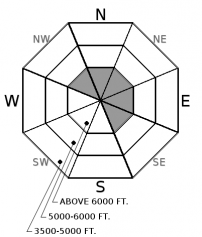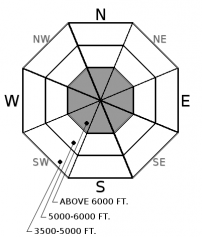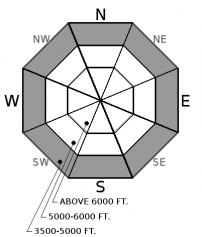| Sunday | Sunday Night | Monday | |
|---|---|---|---|
| Cloud Cover: | Showers tapering with mild conditions. | Showers redeveloping with cooling temperatures. | Showers with continued mild conditions. |
| Temperatures: | 30-39 deg. F. | 19-26 deg. F. | 31-40 deg. F. |
| Wind Direction: | Southwest | Southwest | South-southwest |
| Wind Speed: | 7-8 mph | 9-10 mph with gusts to 21 | 7-8 mph with gusts to 18 |
| Snowfall: | 0-1 in. | 1 in. | 1-3 in. |
| Snow Line: |
Whitefish Range
Swan Range
Flathead Range and Glacier National Park
How to read the forecast
The avalanche danger is MODERATE above 6000 feet. New snow overnight, combined with wind, has formed fresh wind slabs and added weight to existing slabs. In areas of favored snowfall storm slabs should be expected. In some locations these slabs are being deposited onto a crust. Below 5000 feet the wet loose avalanche danger may rise throughout the day with warming temperatures. Pay attention to changing conditions and evaluate the snowpack and your terrain choices carefully.

2. Moderate
?
Above 6500 ft.
1. Low
?
5000-6500 ft.
1. Low
?
3500-5000 ft.
- 1. Low
- 2. Moderate
- 3. Considerable
- 4. High
- 5. Extreme
-
Type ?
-
Aspect/Elevation ?

-
Likelihood ?CertainVery LikelyLikelyPossible
 Unlikely
Unlikely -
Size ?HistoricVery LargeLargeSmall

Snow totals of up to 8" overnight, combined with light winds and moderate gusts, have formed thin fresh wind slabs. Due to our current southwest flow pattern these slabs will be found on typical leeward slopes on the eastern side of the compass. In some locations these slabs are being deposited onto a rain crust or a relatively slippery layer of dense snow. Wind slabs that were formed over the past couple of days have become more substantial as this recent round of snow and wind adds mass to these features. Rounded pillows near ridgelines is a tell tale sign of a wind slab. Cracks shooting out from under your skis or sled are a great indication of unstable snow and that wind-loaded slopes should be avoided.
-
Type ?
-
Aspect/Elevation ?

-
Likelihood ?CertainVery LikelyLikelyPossible
 Unlikely
Unlikely -
Size ?HistoricVery LargeLargeSmall

Upper elevation weather stations are reporting up to 8" of new snow overnight. This snow came in relatively warm and dense which is the right recipe for creating storm slabs. In some locations this new snow is being deposited onto a crust or a smooth dense layer which should add to the problem. These storm slabs will be thin and easy to identify. Cracking under your skis or machine is an obvious sign of a fresh slab.
-
Type ?
-
Aspect/Elevation ?

-
Likelihood ?CertainVery LikelyLikelyPossible
 Unlikely
Unlikely -
Size ?HistoricVery LargeLargeSmall

Mild temperatures overnight, combined with up to 0.5" of rain, has added weight and instability to our low elevation snowpack. This snowpack has a poor structure and current weather conditions are only making things worse. This elevation band has been worked over by recent warm wet weather events but triggering a wet loose slide on a steep slope may become possible as this surface warms throughout the day. These slides should be small and manageable but could knock you off your feet or machine. Be alert while traveling immediately above steep gully features.
We have not observed or been informed of any avalanches occurring on the January 19th crust or any other persistent weak layer since late last week. However, in some places stability tests are still showing reactive results around the January 19 crust and, in isolated locations, the depth hoar at the base of the snowpack is reactive as well. Even though these layers have not produced any avalanches lately, it is still important to be aware that in some locations in the advisory area there is a poor snowpack structure with buried weak layers that may still be reactive. Because these weak layers do not always present obvious signs of instability, digging into the snowpack is the best way to determine their location and reactivity. Also you are more likely to find and/or trigger one of these weak layers in steep rocky terrain that typically has a more shallow snowpack.
We would like to thank all those who have been submitting observations recently. These observations are invaluable and improve our forecasts. Several observers have submitted reports from across the advisory area documenting the widespread avalanche activity from last week (see our Observations Page). Thank you!
Saturday: Mark was in Rescue Creek where he noted evidence of the February 4-10 avalanche cycle. At low elevations the surface crust broke down quickly and the moist snowpack became unsupportable. At mid elevations this crust seemed to survive the day better. Riders in the Wounded Buck area of the Swan Range noted evidence of a large wet avalanche that may have been the result of the February 8-9 rain event.
Friday: Zach (FAC intern) and Mark traveled to the Skookoleel Ridge area of the Whitefish Range. We noted up to 4 inches of dense snow on top of a rain crust at upper elevations. Stability test results in our snowpits showed instabilities within the new snow and around the February 8 rain crust. No propagation was observed in our tests.
Thursday: We were in the Whitefish Range east of Whitefish Mountain Resort (observation). Very foggy weather limited visibility but no recent avalanche activity was observed. Last week's rain crust was breaking down making for a little better skiing. Two snowpits, one a NNE aspect, and another on a SE aspect yielded no propagation on any layer and no fractures on the Jan 19th crust which was about 1 m below the surface. BNSF Avalanche Safety observed a few small wet loose avalanches in some of the terrain above the railroad in Southern Glacier Park.
See below for all observations this season.
Cloudy skies overnight have kept temperatures mild with valley floor locations at or above freezing and upper elevations just below freezing. Precipitation amounts of up to 0.5" have been recorded at low elevations with slightly higher amounts at upper elevations where up to 8" of new snow has been recorded. Currently, above 6000 feet, temperatures are 27-34°F with light winds out of the southwest at 5-10 mph with gusts of 11-19 mph. Precipitation should taper off this morning with mild conditions with temperatures in the low to mid 30s ºF above 6000 feet and into the upper 30s ºF at elevations below this. Light southwest winds will continue through the day.
| 0600 temperature: | 27-34 deg. F. |
| Max. temperature in the last 24 hours: | 30-40 deg. F. |
| Average wind direction during the last 24 hours: | west - southwest |
| Average wind speed during the last 24 hours: | 1-13 mph |
| Maximum wind gust in the last 24 hours: | 19-22 mph |
| New snowfall in the last 24 hours: | 0-8 inches |
| Total snow depth: | 75-103 inches |
This advisory applies only to backcountry areas outside established ski area boundaries. This advisory describes general avalanche conditions and local variations always occur. This advisory expires at midnight on the posted day unless otherwise noted. The information in this advisory is provided by the USDA Forest Service who is solely responsible for its content.


































